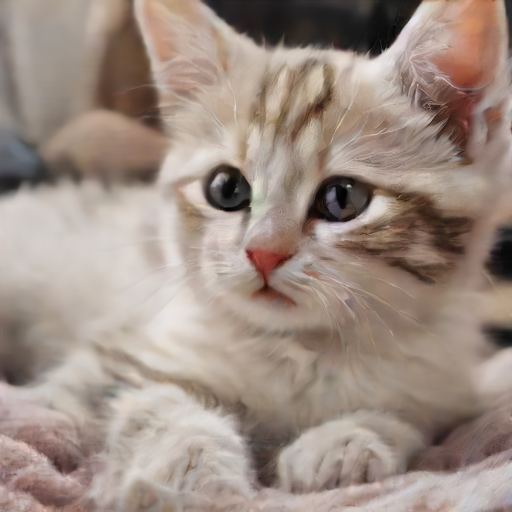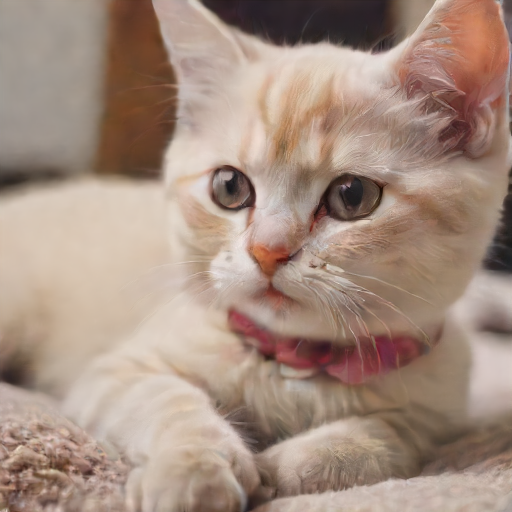Single step image generation using SDXL-turbo and OpenVINO#
This Jupyter notebook can be launched after a local installation only.
SDXL-Turbo is a fast generative text-to-image model that can synthesize photorealistic images from a text prompt in a single network evaluation. SDXL-Turbo is a distilled version of SDXL 1.0, trained for real-time synthesis. SDXL Turbo is based on a novel distillation technique called Adversarial Diffusion Distillation (ADD), which enables the model to synthesize image outputs in a single step and generate real-time text-to-image outputs while maintaining high sampling fidelity. More details about this distillation approach can be found in technical report. More details about model can be found in Stability AI blog post.
Previously, we already discussed how to launch Stable Diffusion XL model using OpenVINO in the following notebook, in this tutorial we will focus on the SDXL-turbo version. Additionally, to improve image decoding speed, we will use Tiny Autoencoder, which is useful for real-time previewing of the SDXL generation process.
We will use a pre-trained model from the Hugging Face Diffusers library. To simplify the user experience, the Hugging Face Optimum Intel library is used to convert the models to OpenVINO™ IR format.
Table of contents:
Installation Instructions#
This is a self-contained example that relies solely on its own code.
We recommend running the notebook in a virtual environment. You only need a Jupyter server to start. For details, please refer to Installation Guide.
Prerequisites#
%pip install -q --extra-index-url https://download.pytorch.org/whl/cpu \
"torch>=2.1" transformers "diffusers>=0.24.0" "git+https://github.com/huggingface/optimum-intel.git" "gradio>=4.19" "peft>=0.6.2" "openvino>=2023.3.0"
Convert model to OpenVINO format#
sdxl-turbo is available for downloading via the HuggingFace hub. We will use optimum-cli interface for exporting it into OpenVINO Intermediate Representation (IR) format.
Optimum CLI interface for converting models supports export to OpenVINO (supported starting optimum-intel 1.12 version). General command format:
optimum-cli export openvino --model <model_id_or_path> --task <task> <output_dir>
where task is task to export the model for, if not specified, the task
will be auto-inferred based on the model. Available tasks depend on the
model, for sdxl should be selected stable-diffusion-xl
You can find a mapping between tasks and model classes in Optimum TaskManager documentation.
Additionally, you can specify weights compression --weight-format
for the model compression. Please note, that for INT8/INT4, it is
necessary to install nncf.
Full list of supported arguments available via --help For more
details and examples of usage, please check optimum
documentation.
For Tiny Autoencoder, we will use ov.convert_model function for
obtaining ov.Model and save it using ov.save_model. Model
consists of 2 parts that used in pipeline separately: vae_encoder
for encoding input image in latent space in image-to-image generation
task and vae_decoder that responsible for decoding diffusion result
back to image format.
from pathlib import Path
import requests
if not Path("notebook_utils.py").exists():
r = requests.get(
url="https://raw.githubusercontent.com/openvinotoolkit/openvino_notebooks/latest/utils/notebook_utils.py",
)
open("notebook_utils.py", "w").write(r.text)
# Read more about telemetry collection at https://github.com/openvinotoolkit/openvino_notebooks?tab=readme-ov-file#-telemetry
from notebook_utils import collect_telemetry
collect_telemetry("sdxl-turbo.ipynb")
model_dir = Path("./model")
sdxl_model_id = "stabilityai/sdxl-turbo"
tae_id = "madebyollin/taesdxl"
skip_convert_model = model_dir.exists()
import torch
import openvino as ov
from diffusers import AutoencoderTiny
import gc
class VAEEncoder(torch.nn.Module):
def __init__(self, vae):
super().__init__()
self.vae = vae
def forward(self, sample):
return self.vae.encode(sample)
class VAEDecoder(torch.nn.Module):
def __init__(self, vae):
super().__init__()
self.vae = vae
def forward(self, latent_sample):
return self.vae.decode(latent_sample)
def convert_tiny_vae(model_id, output_path):
tiny_vae = AutoencoderTiny.from_pretrained(model_id)
tiny_vae.eval()
vae_encoder = VAEEncoder(tiny_vae)
ov_model = ov.convert_model(vae_encoder, example_input=torch.zeros((1, 3, 512, 512)))
ov.save_model(ov_model, output_path / "vae_encoder/openvino_model.xml")
tiny_vae.save_config(output_path / "vae_encoder")
vae_decoder = VAEDecoder(tiny_vae)
ov_model = ov.convert_model(vae_decoder, example_input=torch.zeros((1, 4, 64, 64)))
ov.save_model(ov_model, output_path / "vae_decoder/openvino_model.xml")
tiny_vae.save_config(output_path / "vae_decoder")
if not skip_convert_model:
!optimum-cli export openvino --model $sdxl_model_id --task stable-diffusion-xl $model_dir --weight-format fp16
convert_tiny_vae(tae_id, model_dir)
Text-to-image generation#
Text-to-image generation lets you create images using text description.
To start generating images, we need to load models first. To load an
OpenVINO model and run an inference with Optimum and OpenVINO Runtime,
you need to replace diffusers StableDiffusionXLPipeline with Optimum
OVStableDiffusionXLPipeline. Pipeline initialization starts with
using from_pretrained method, where a directory with OpenVINO models
should be passed. Additionally, you can specify an inference device.
Select inference device for text-to-image generation#
from notebook_utils import device_widget
device = device_widget()
device
from optimum.intel.openvino import OVStableDiffusionXLPipeline
text2image_pipe = OVStableDiffusionXLPipeline.from_pretrained(model_dir, device=device.value)
Compiling the vae_decoder to AUTO ...
Compiling the unet to AUTO ...
Compiling the text_encoder to AUTO ...
Compiling the text_encoder_2 to AUTO ...
Compiling the vae_encoder to AUTO ...
The pipeline interface is similar to original
StableDiffusionXLPipeline. We should provide text prompt. The
default number of steps is 50, while sdxl-turbo required only 1 step.
According to the information provided in model card, model does not use
negative prompt and guidance scale and this parameters should be
disabled using guidance_scale = 0
import numpy as np
prompt = "cute cat"
image = text2image_pipe(
prompt,
num_inference_steps=1,
height=512,
width=512,
guidance_scale=0.0,
generator=np.random.RandomState(987),
).images[0]
image.save("cat.png")
image
0%| | 0/1 [00:00<?, ?it/s]

del text2image_pipe
gc.collect();
Image-to-Image generation#
Image-to-image generation lets you transform images to match the
characteristics provided in the text description. We can reuse the
already converted model for running the Image2Image generation pipeline.
For that, we should replace OVStableDiffusionXLPipeline with
OVStableDiffusionXLImage2ImagePipeline.
from optimum.intel import OVStableDiffusionXLImg2ImgPipeline
image2image_pipe = OVStableDiffusionXLImg2ImgPipeline.from_pretrained(model_dir, device=device.value)
Compiling the vae_decoder to AUTO ...
Compiling the unet to AUTO ...
Compiling the vae_encoder to AUTO ...
Compiling the text_encoder_2 to AUTO ...
Compiling the text_encoder to AUTO ...
photo_prompt = "a cute cat with bow tie"
strength parameter is important for the image-to-image generation
pipeline. It is a value between 0.0 and 1.0, that controls the amount of
noise that is added to the input image. Values that approach 1.0 enable
lots of variations but will also produce images that are not
semantically consistent with the input, then close to 0, less noise will
be added and the target image will preserve source image content.
strength has an impact not only on a number of noise but also the number
of generation steps. The number of denoising iterations in the
image-to-image generation pipeline is calculated as
int(num_inference_steps * strength). With sdxl-turbo we should be
careful with selecting num_inference_steps and strength to
produce the correct result and make sure that the number of steps used
in pipeline >= 1 after applying strength multiplication. e.g. in example
below, we will use num_inference_steps=2 and stength=0.5,
finally, we get 0.5 * 2.0 = 1 step in our pipeline.
photo_image = image2image_pipe(
photo_prompt,
image=image,
num_inference_steps=2,
generator=np.random.RandomState(511),
guidance_scale=0.0,
strength=0.5,
).images[0]
photo_image.save("cat_tie.png")
photo_image
0%| | 0/1 [00:00<?, ?it/s]

del image2image_pipe
gc.collect();
Quantization#
NNCF enables
post-training quantization by adding quantization layers into model
graph and then using a subset of the training dataset to initialize the
parameters of these additional quantization layers. Quantized operations
are executed in INT8 instead of FP32/FP16 making model
inference faster.
According to SDXL-Turbo Model structure, the UNet model takes up
significant portion of the overall pipeline execution time. Now we will
show you how to optimize the UNet part using
NNCF to reduce
computation cost and speed up the pipeline. Quantizing the rest of the
SDXL pipeline does not significantly improve inference performance but
can lead to a substantial degradation of accuracy.
The optimization process contains the following steps:
Create a calibration dataset for quantization.
Run
nncf.quantize()to obtain quantized model.Save the
INT8model usingopenvino.save_model()function.
Please select below whether you would like to run quantization to improve model inference speed.
from notebook_utils import quantization_widget
skip_for_device = "GPU" in device.value
to_quantize = quantization_widget(not skip_for_device)
to_quantize
Checkbox(value=True, description='Quantization')
# Fetch `skip_kernel_extension` module
import requests
if not Path("skip_kernel_extension.py").exists():
r = requests.get(
url="https://raw.githubusercontent.com/openvinotoolkit/openvino_notebooks/latest/utils/skip_kernel_extension.py",
)
open("skip_kernel_extension.py", "w").write(r.text)
int8_pipe = None
core = ov.Core()
%load_ext skip_kernel_extension
Prepare calibration dataset#
We use a portion of
conceptual_captions
dataset from Hugging Face as calibration data. To collect intermediate
model inputs for calibration we should customize CompiledModel.
UNET_INT8_OV_PATH = model_dir / "optimized_unet" / "openvino_model.xml"
def disable_progress_bar(pipeline, disable=True):
if not hasattr(pipeline, "_progress_bar_config"):
pipeline._progress_bar_config = {"disable": disable}
else:
pipeline._progress_bar_config["disable"] = disable
%%skip not $to_quantize.value
import datasets
import numpy as np
from tqdm.notebook import tqdm
from transformers import set_seed
from typing import Any, Dict, List
set_seed(1)
class CompiledModelDecorator(ov.CompiledModel):
def __init__(self, compiled_model: ov.CompiledModel, data_cache: List[Any] = None):
super().__init__(compiled_model)
self.data_cache = data_cache if data_cache else []
def __call__(self, *args, **kwargs):
self.data_cache.append(*args)
return super().__call__(*args, **kwargs)
def collect_calibration_data(pipe, subset_size: int) -> List[Dict]:
original_unet = pipe.unet.request
pipe.unet.request = CompiledModelDecorator(original_unet)
dataset = datasets.load_dataset("google-research-datasets/conceptual_captions", split="train", trust_remote_code=True).shuffle(seed=42)
disable_progress_bar(pipe)
# Run inference for data collection
pbar = tqdm(total=subset_size)
diff = 0
for batch in dataset:
prompt = batch["caption"]
if len(prompt) > pipe.tokenizer.model_max_length:
continue
_ = pipe(
prompt,
num_inference_steps=1,
height=512,
width=512,
guidance_scale=0.0,
generator=np.random.RandomState(987)
)
collected_subset_size = len(pipe.unet.request.data_cache)
if collected_subset_size >= subset_size:
pbar.update(subset_size - pbar.n)
break
pbar.update(collected_subset_size - diff)
diff = collected_subset_size
calibration_dataset = pipe.unet.request.data_cache
disable_progress_bar(pipe, disable=False)
pipe.unet.request = original_unet
return calibration_dataset
%%skip not $to_quantize.value
if not UNET_INT8_OV_PATH.exists():
text2image_pipe = OVStableDiffusionXLPipeline.from_pretrained(model_dir, device=device.value)
unet_calibration_data = collect_calibration_data(text2image_pipe, subset_size=200)
Compiling the vae_decoder to AUTO ...
Compiling the unet to AUTO ...
Compiling the text_encoder_2 to AUTO ...
Compiling the vae_encoder to AUTO ...
Compiling the text_encoder to AUTO ...
0%| | 0/200 [00:00<?, ?it/s]
Run quantization#
Create a quantized model from the pre-trained converted OpenVINO model.
Quantization of the first and last Convolution layers impacts the
generation results. We recommend using IgnoredScope to keep accuracy
sensitive Convolution layers in FP16 precision.
NOTE: Quantization is time and memory consuming operation. Running quantization code below may take some time.
%%skip not $to_quantize.value
import nncf
from nncf.scopes import IgnoredScope
UNET_OV_PATH = model_dir / "unet" / "openvino_model.xml"
if not UNET_INT8_OV_PATH.exists():
unet = core.read_model(UNET_OV_PATH)
quantized_unet = nncf.quantize(
model=unet,
model_type=nncf.ModelType.TRANSFORMER,
calibration_dataset=nncf.Dataset(unet_calibration_data),
ignored_scope=IgnoredScope(
names=[
"__module.model.conv_in/aten::_convolution/Convolution",
"__module.model.up_blocks.2.resnets.2.conv_shortcut/aten::_convolution/Convolution",
"__module.model.conv_out/aten::_convolution/Convolution"
],
),
)
ov.save_model(quantized_unet, UNET_INT8_OV_PATH)
Output()
Output()
INFO:nncf:3 ignored nodes were found by name in the NNCFGraph
INFO:nncf:448 ignored nodes were found by name in the NNCFGraph
INFO:nncf:Not adding activation input quantizer for operation: 6 __module.model.conv_in/aten::_convolution/Convolution
14 __module.model.conv_in/aten::_convolution/Add
INFO:nncf:Not adding activation input quantizer for operation: 317 __module.model.up_blocks.2.resnets.2.conv_shortcut/aten::_convolution/Convolution
543 __module.model.up_blocks.2.resnets.2.conv_shortcut/aten::_convolution/Add
INFO:nncf:Not adding activation input quantizer for operation: 1242 __module.model.conv_out/aten::_convolution/Convolution
1426 __module.model.conv_out/aten::_convolution/Add
Output()
Output()
Let us check predictions with the quantized UNet using the same input data.
%%skip not $to_quantize.value
from IPython.display import display
int8_text2image_pipe = OVStableDiffusionXLPipeline.from_pretrained(model_dir, device=device.value, compile=False)
int8_text2image_pipe.unet.model = core.read_model(UNET_INT8_OV_PATH)
int8_text2image_pipe.unet.request = None
prompt = "cute cat"
image = int8_text2image_pipe(prompt, num_inference_steps=1, height=512, width=512, guidance_scale=0.0, generator=np.random.RandomState(987)).images[0]
display(image)
Compiling the text_encoder to AUTO ...
Compiling the text_encoder_2 to AUTO ...
0%| | 0/1 [00:00<?, ?it/s]
Compiling the unet to AUTO ...
Compiling the vae_decoder to AUTO ...

%%skip not $to_quantize.value
int8_image2image_pipe = OVStableDiffusionXLImg2ImgPipeline.from_pretrained(model_dir, device=device.value, compile=False)
int8_image2image_pipe.unet.model = core.read_model(UNET_INT8_OV_PATH)
int8_image2image_pipe.unet.request = None
photo_prompt = "a cute cat with bow tie"
photo_image = int8_image2image_pipe(photo_prompt, image=image, num_inference_steps=2, generator=np.random.RandomState(511), guidance_scale=0.0, strength=0.5).images[0]
display(photo_image)
Compiling the text_encoder to AUTO ...
Compiling the text_encoder_2 to AUTO ...
Compiling the vae_encoder to AUTO ...
0%| | 0/1 [00:00<?, ?it/s]
Compiling the unet to AUTO ...
Compiling the vae_decoder to AUTO ...

%%skip not $to_quantize.value
fp16_ir_model_size = UNET_OV_PATH.with_suffix(".bin").stat().st_size / 1024
quantized_model_size = UNET_INT8_OV_PATH.with_suffix(".bin").stat().st_size / 1024
print(f"FP16 model size: {fp16_ir_model_size:.2f} KB")
print(f"INT8 model size: {quantized_model_size:.2f} KB")
print(f"Model compression rate: {fp16_ir_model_size / quantized_model_size:.3f}")
FP16 model size: 5014578.62 KB
INT8 model size: 2517944.84 KB
Model compression rate: 1.992
Compare inference time of the FP16 and INT8 models#
To measure the inference performance of the FP16 and INT8
pipelines, we use median inference time on calibration subset.
NOTE: For the most accurate performance estimation, it is recommended to run
benchmark_appin a terminal/command prompt after closing other applications.
%%skip not $to_quantize.value
import time
validation_size = 7
calibration_dataset = datasets.load_dataset("google-research-datasets/conceptual_captions", split="train", trust_remote_code=True)
validation_data = []
for batch in calibration_dataset:
prompt = batch["caption"]
validation_data.append(prompt)
def calculate_inference_time(pipe, dataset):
inference_time = []
disable_progress_bar(pipe)
for idx, prompt in enumerate(dataset):
start = time.perf_counter()
image = pipe(
prompt,
num_inference_steps=1,
guidance_scale=0.0,
generator=np.random.RandomState(23)
).images[0]
end = time.perf_counter()
delta = end - start
inference_time.append(delta)
if idx >= validation_size:
break
disable_progress_bar(pipe, disable=False)
return np.median(inference_time)
%%skip not $to_quantize.value
int8_latency = calculate_inference_time(int8_text2image_pipe, validation_data)
text2image_pipe = OVStableDiffusionXLPipeline.from_pretrained(model_dir, device=device.value)
fp_latency = calculate_inference_time(text2image_pipe, validation_data)
print(f"FP16 pipeline latency: {fp_latency:.3f}")
print(f"INT8 pipeline latency: {int8_latency:.3f}")
print(f"Text-to-Image generation speed up: {fp_latency / int8_latency:.3f}")
Compiling the vae_decoder to AUTO ...
Compiling the unet to AUTO ...
Compiling the vae_encoder to AUTO ...
Compiling the text_encoder to AUTO ...
Compiling the text_encoder_2 to AUTO ...
FP16 pipeline latency: 1.775
INT8 pipeline latency: 0.673
Text-to-Image generation speed up: 2.636
Interactive Demo#
Now, you can check model work using own text descriptions. Provide text prompt in the text box and launch generation using Run button. Additionally you can control generation with additional parameters: * Seed - random seed for initialization * Steps - number of generation steps * Height and Width - size of generated image
Please note that increasing image size may require to increasing number of steps for accurate result. We recommend running 104x1024 resolution image generation using 4 steps.
Please select below whether you would like to use the quantized model to launch the interactive demo.
import ipywidgets as widgets
quantized_model_present = UNET_INT8_OV_PATH.exists()
use_quantized_model = widgets.Checkbox(
value=True if quantized_model_present else False,
description="Use quantized model",
disabled=False,
)
use_quantized_model
Checkbox(value=True, description='Use quantized model')
text2image_pipe = OVStableDiffusionXLPipeline.from_pretrained(model_dir, device=device.value)
if use_quantized_model.value:
if not quantized_model_present:
raise RuntimeError("Quantized model not found.")
text2image_pipe.unet.model = core.read_model(UNET_INT8_OV_PATH)
text2image_pipe.unet.request = core.compile_model(text2image_pipe.unet.model, device.value)
def generate_from_text(text, seed, num_steps, height, width):
result = text2image_pipe(
text,
num_inference_steps=num_steps,
guidance_scale=0.0,
generator=np.random.RandomState(seed),
height=height,
width=width,
).images[0]
return result
if not Path("gradio_helper.py").exists():
r = requests.get(url="https://raw.githubusercontent.com/openvinotoolkit/openvino_notebooks/latest/notebooks/sdxl-turbo/gradio_helper.py")
open("gradio_helper.py", "w").write(r.text)
from gradio_helper import make_demo
demo = make_demo(fn=generate_from_text, quantized=use_quantized_model.value)
try:
demo.launch(debug=False)
except Exception:
demo.launch(share=True, debug=False)
# If you are launching remotely, specify server_name and server_port
# EXAMPLE: `demo.launch(server_name='your server name', server_port='server port in int')`
# To learn more please refer to the Gradio docs: https://gradio.app/docs/